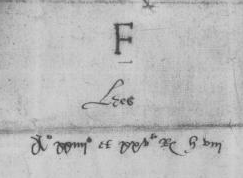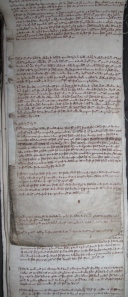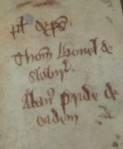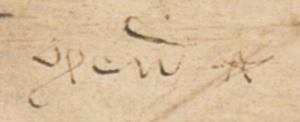My introduction to document listing practices in Thomas Cromwell’s office can be found at Postcards from the Past – The National Archives published as part of the International Conference on the History of Records and Archives (ICHORA) 2022.
Cromwell’s Records – Filing Annotations

“C Junii”
National Archives SP 60/2 f.48 (dorse detail)
1534 seems to be a transitional period for the manner in which Thomas Cromwell’s incoming correspondence was managed. Investigating starts at the back of these letters, the thicket of signs acquired over 500 years: folio numbering, dating, annotations of subjects, names and matters. At the bottom layer of this thicket is the letter-writer’s superscription, and then annotations of receipt, on what becomes a scribal work surface. A few unique filing annotations appear for a short period of time which seem to be linked to the record-keeping practice which I began to investigate in the previous post on cover sheets.

“F July”
National Archives SP 60/2 f.50 (dorse detail)
Evidence for this practice barely makes an appearance at all in the State Papers, but the following focus on these types of annotation will show an indexical method at work. Most annotations on correspondence such as the fairly habitual recording of the name of the author do not have such a specific function. Along with the cover sheets of the previous post, these are contemporaneous and process-specific. I will start with some observations and introduce a hypothesis to account for their use. (1)
There are 3 types of evidence for some kind of systematic organization that appear on the dorse of correspondence in the 1533-1534 period: the cover sheets for the span of one or two regnal years already described,
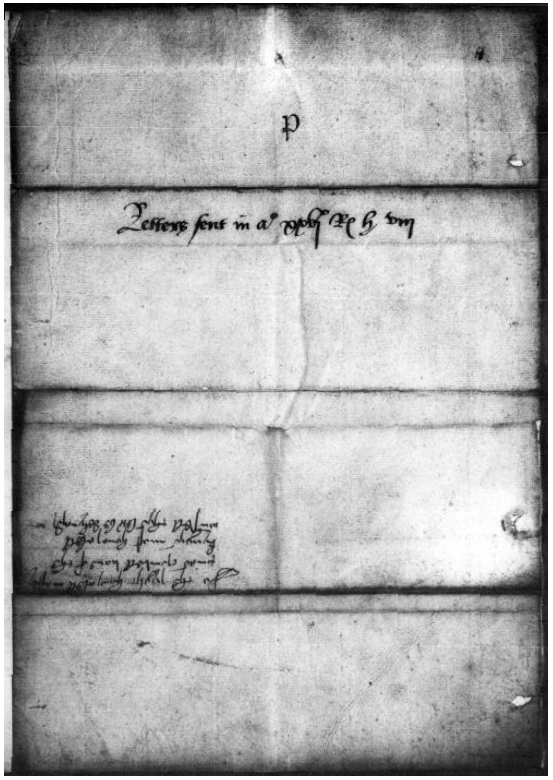
“P”
“Letters sent in anno xxvi R H VIII”
National Archives SP 1/79 f.78 (dorse)
a further 9 or 10 items on which only a letter of the alphabet is informally drawn,
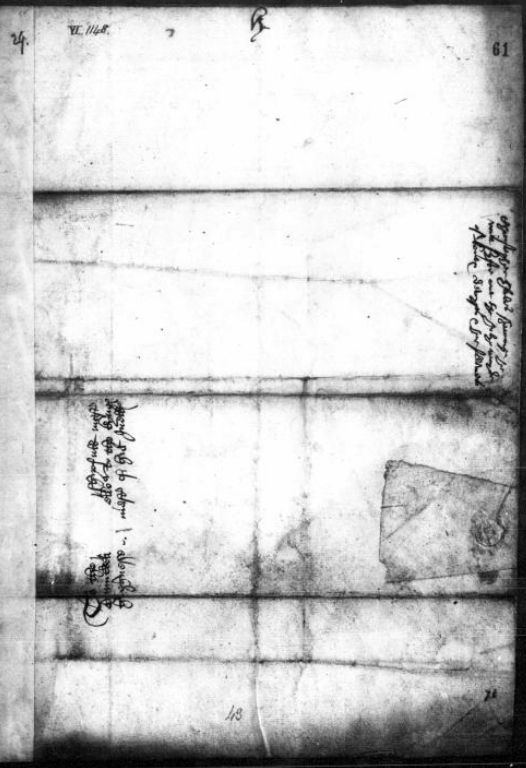
“H”
National Archives SP 1/79 f.61 (dorse)
and approximately 20 on which there are a combination of letter and month along one edge.
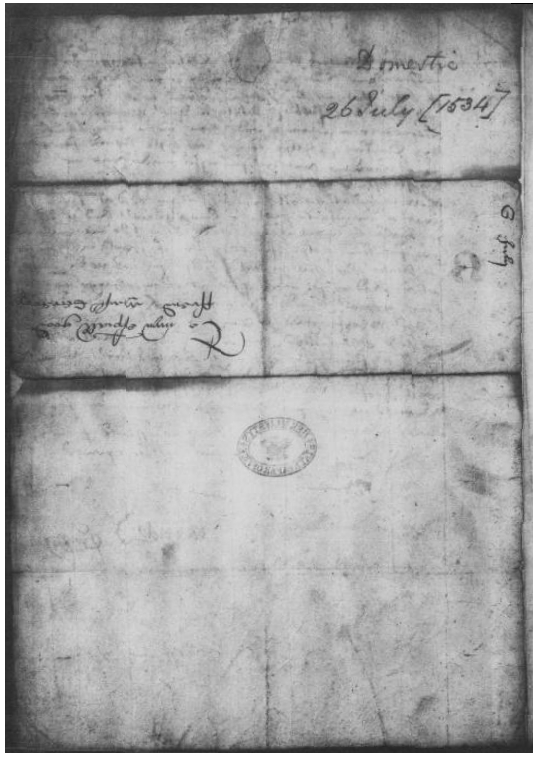
“G July”
National Archives SP 1/85 f.72 (dorse)
The alphabetical characters on all 3 types index the name of the author of the correspondence on which they are placed. The letter and month combination index the author and month written.
First, considering this combination of letter and month, it is a remnant of an unknown but particular goal-directed activity. When combined with a year, the two abstracted elements provide a filing location, and an intellectual order, although the relationship is not given: months arranged by name or names arranged by month? Being such a rare and short-lived form of annotation we can assume it was not a regular office practice, but peculiar to one individual, who followed a habit, or invented it for the occasion.

“C July”
National Archives SP 1/85 f.45 (detail from dorse)
The clerical occasion may have been sorting for future filing, returning an item to a place retrieved from, or some other interaction with the organization of correspondence. Whatever its necessity, it points to a certain structure, and what must have been a large volume of records, otherwise its use would not have been needed.
When considering that the 3 types could form inter-related elements of one system, their functions may become clearer. The following table illustrates the range by alphabet and the known or assumed dates given in the calendar entries for each piece of correspondence:
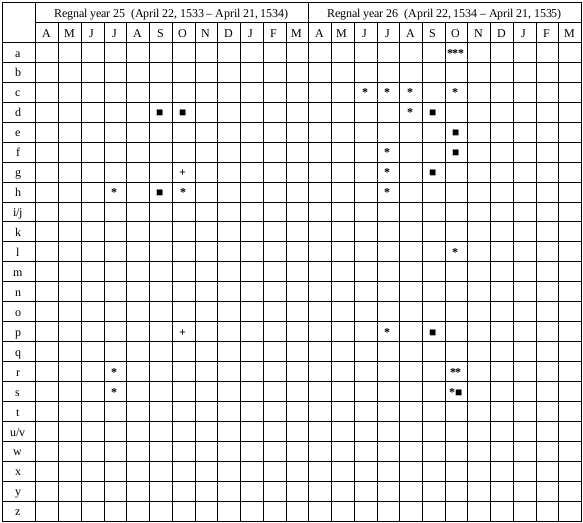
Dates of correspondence and their annotations
* = Month and letter annotations
■ = Single letter annotations
+ = 26th RY cover sheets (one is not dated so omitted here)
One can immediately observe that there are two groupings over time, from June/July to October, in both regnal years 25 and 26. A kind of mirroring can be observed in the continuity of surviving letter groups over the two years. It seems odd however that someone would be performing the same task in the same way for only these months over two years. The calendared dates may be wrong in some instances, but there are enough dates which are obviously correct to make this possibility irrelevant.
I think to make sense of this chronological range over two years we have to make an assumption: that in 1534 these items of 1533 correspondence (of any of the 3 types) were misfiled, and brought into the 26th regnal year aggregation. I will come to the reasoning for this shortly. If we accept this then all these annotations should be considered as made in 1534.
If the single regal year aggregation (year 26) is a development of the previous two-year aggregation then the next logical division would be monthly, in response to an increasing amount of correspondence to manage. This is what the letter/month annotations point to. For regnal year 26 I think incoming correspondence was on receipt collected in groups by the initial letter of the author’s name, and within those groups chronologically, but face down. This regular chronological accumulation may be a difference from the previous two regnal year aggregates. It is how most modern office files grow, forming themselves in reverse chronological order, with the most recent documents on top.

“D August”
National Archives SP 1/85 f.106 (detail from dorse)
The 26th regnal year did not end in October, so why do the annotations end there? I can think of two possible reasons. September 29 is Michaelmas, a division frequently used at the time for accounting periods; in fact inventories of Cromwell’s papers made by his servants frequently make use of this as a division. Perhaps more significantly, in early October Cromwell obtained the office of Master of the Rolls, which did not replace his position as principal secretary, but augmented his power. It increased his staff and shifted his base of operations to include a new physical location on Chancery Lane. October 1534 then would have been a time of putting things in order by his staff in his previous ‘home office’.
It is this activity that can account for the creation of the letter and month annotations. They are pieces of correspondence which were found in out of the way places, or otherwise presented for filing within the already accumulated April to October stacks or files. Around the same time, in anticipation of closing these files, the top dorse was given a temporary letter label. This accounts for the pattern we see in the table above for the single-letter annotations on correspondence: they are written in September or October.
The last step in the process of creating these files was the more formal regnal year labeling, on the topmost dorse of the by-now bound file, of which there are 3 examples extant. Again we can look to their dating to confirm this. One was written on October 6, one was written in October 14th, and the third is unknown. This last step seems to confirm their chronological order, at least to the extant of collecting by month. The cover sheets of the previous years do not have this pattern.
So what we have, represented by these inconspicuous labels, is a sequence of interrelated activities: filing, labeling files, and then closing files with the addition of further identification of the series.
Following are the annotations and UK National Archives document references:
|
SP 1/86 f.34 |
A |
October |
|
SP 1/86 f.110 |
A |
October |
|
SP 1/86 f.127 |
A |
October |
|
SP 60/2 f.48 |
C |
June |
|
SP 1/85 f.45 |
C |
July |
|
SP 1/85 f.103 |
C |
August |
|
SP 1/86 f.50 |
C |
October |
|
SP 1/85 f.106 |
D |
August |
|
SP 1/85 f.144 |
D |
– |
|
SP 1/79 f.146 |
D |
– |
|
SP 1/79 f.96 |
D |
– |
|
SP 1/86 f.18 |
E? |
– |
|
SP 60/2 f.50 |
F |
July |
|
SP 1/86 f.14 |
F |
– |
|
SP 1/85 f.72 |
G |
July |
|
SP 1/85 f.178 |
G? |
– |
|
SP 1/238 f.125 |
G? |
– |
|
SP 1/238 f.92 |
H |
July |
|
SP 1/85 f.47 |
H |
July |
|
SP 1/79 f.166 |
H |
October |
|
SP 1/79 f.61 |
H |
– |
|
SP 1/86 f.128 |
L |
October |
|
SP 1/85 f.62 |
P |
July |
|
SP 1/85 f.170 |
P |
– |
|
SP 1/77 f.185 |
R |
July |
|
SP 1/86 f.32 |
R |
October |
|
SP 1/86 f.106 |
R |
October |
|
SP 1/78 f.55 |
S |
July |
|
SP 1/86 f.23 |
S |
October |
|
SP 1/86 f.12 |
S |
– |
(1) This evidence is restricted to what I have observed on the surrogate images, not the original records in the National Archives. I take these marks to be contemporaneous with their absorption into Cromwell’s record-keeping systems because their handwriting seems consistent, as well as the fact a few of the months recorded are not included in the text of the correspondence, so must of been known by the scribe (i.e. SP 1/86 f.128). The logic of the reconstruction also speaks to their creation while the office was active.
Cromwell’s Records – Incoming Correspondence to 1535
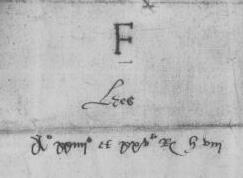
State Papers 1/74 f.43 (dorse)
If one had an interest in the government record-keeping practices of Tudor England the documentary source one would naturally turn to is the collection of State Papers housed in the National Archives.* The nature of their present organization however, an artificial collection of chronological order from a variety of records creators, frustrates any understanding. The disappearance of any original order has produced the present contorted physicality of these records. Nevertheless, one would expect to see some evidence of control over information and evidence.
I think it is worthwhile to have a close look at what is available and see what we can see. Perhaps there are techniques of documentary organization and information management which are not obvious, but are there in some fragmented form. I’ll focus on the records of a person whose fame for administrative skills would seem to offer us the best potential, Thomas Cromwell (d.1540). The survival of copious incoming correspondence, as well as large inventories of a variety of document types, attest to the fact he retained a large amount of active and inactive records, for ongoing administration or future reference or otherwise. The breadth and scale of document-supported operations Cromwell conducted suggest a need for managing their effective use. However, the office’s methods of organizing these documents remains under-described.**
The management of incoming correspondence in early modern England followed a basic pattern. After a piece of correspondence was opened and read by a secretary or one of his staff it could be re-folded into a docket shape and often endorsed, usually with the sender’s name, perhaps a brief summary of the matter, and perhaps a date. This process we can observe on most of the discrete items kept by Cromwell now remaining.
There is also physical evidence of other forms of control. An examination of the dorse sides of the Cromwellian correspondence certainly shows evidence of folded docket management, but also, I would propose, another stage of unfolded accumulations. These accumulations, we can call them files, collected together incoming correspondence for particular time periods and in an alphabetical arrangement, and which were bound at the head. I don’t know when this aggregate was created, but it seems likely to me to be while in semi-active use, sometime before Cromwell was executed in 1540.
Their arrangement was alphabetical. For instance, a letter dated October 17, 1532 includes an inscriptional-styled roman character ‘H’ on the dorse along with a description (Lres ao xxiiijo et xxvo R H viii) indicating that this was used as a cover sheet for letters from the 24th and 25th years of the reign of Henry VIII, that is from April 22nd 1532 to April 21st 1534:
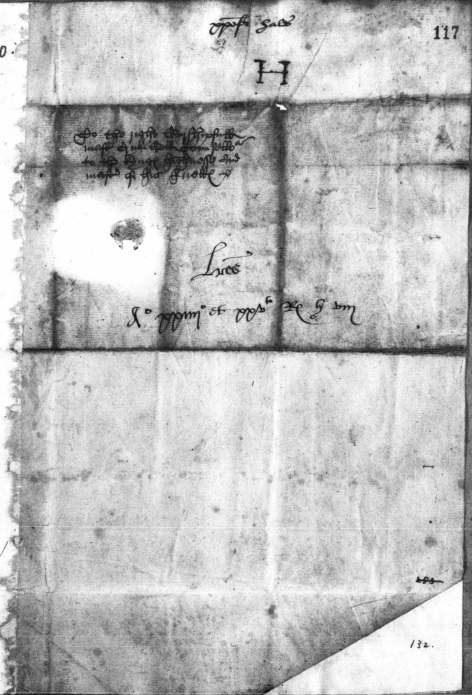
State Papers 1/17 f.117 (dorse)
This piece of correspondence to Cromwell, initially endorsed with the name of the sender Christopher Hales, has become a cover sheet for an accumulation of semi-active administrative records. There are also extant cover sheets for the letters F, G, I/J, L and O in the same format and covering the same time period.
That this was part of a physical file can be seen from the puncture at the top of each cover. In the example above, directly under the abbreviated “Christopher”, is a hole in the paper where it would have been tied together with other “H” correspondence. For any other extant correspondence then, this puncture mark left by the file’s stitch is an indication it could have been included in one of these files. My rough survey of letters to Cromwell at this time indicate about 20-35% were included in this type of filing.
Each cover represents the surname, or corporate name, of a writer on which it is labeled. The labels are written on letters from Sir William Fitzwilliam (Treasurer of the Household), Sir Edward Guldeford (Lord Warden of the Cinque ports), Christopher Hales (Attorney General), Richard Jones (?), Dr. John London (Warden of New College Oxford), and the Town of Oxford. Presumably many other writers would also have been captured in these alphabetical accumulations. The surviving names suggest that these files could have been a core series of incoming correspondence for Cromwell’s office staff; generally they are central figures in the day-to-day administration of the realm.
Although Cromwell is the records creator he is not necessarily the addressee. Fitzwilliam’s correspondence is actually addressed to the Bishop of London, John Stokesley. It was included in Cromwell’s filing system because it was not a private letter; it represented government business. It consists of the king’s instructions to his servants, received from one councilor and forwarded to another. So Cromwell must have acquired it, and kept it, as a councilor carrying out its prescribed or related task. This is before the development of modern bureaucracy, but these written records are just as able to represent a structure of delegated authority and accountability.
In the 26th regnal year the two-regnal-year date range of the files is modified. Now, for a single regnal year, the 26th, there are at least three extant cover sheets with similar labeling, for the letters F, G, and P. Possibly this change reflects an increase in the volume of correspondence: the sorted units are adjusted down in scale for ease of use. Or it is just a new preference.
A curious fact about these three of year 26, which will need to be explained before we really understand this level of organization, is that two of the three writers are the same as two of the six from the previous years: label ‘F’ is on correspondence from Fitzwilliam, and label ‘G’ on Guldeford’s, the same writers of the previous system’s ‘F’ and ‘G’ covers. It seems unlikely to be a coincidence, given the small number of examples. Perhaps it points to a non-chronological and non-alphabetical division within the file by some other category.
There is at least one other cover sheet extant: “Italeon lettres and other matiers / In a° xxvj RH VIII” (SP 1/80 f.199v). I haven’t found others like this, perhaps because they were not regularly made; but it does point to a division of all correspondence into ongoing series. I am assuming the creation of these files was concurrent with the closing of the date range, and not a later organization. The possibility exists that all or some of this labeling is of a later hand, added by custodians after 1540, but I doubt it. In the absence of any evidence to the contrary, it would be more reasonable to assume the original record-keepers had a need for organizing correspondence by author and time period, for the sake of continual finding and managing, after their immediate use was past.
There do not seem to be any cover sheets like these created in Cromwell’s office again. By 1535 this system of managing some of the correspondence primarily by regnal year was either modified somehow, or the cover sheets on the same model are now lost. Without any evidence I think we assume it was probably abandoned for another or similar system. This could be a sign the office was dealing with different kinds of business, or the focus had changed. In fact, in April 1534 Cromwell became Principal Secretary. It may be significant that in October 1534 Cromwell also acquired a new office, Master of the Rolls, and a new physical location for some of his clerical staff.
Analyzing how Cromwell fit into Royal governance provides a key to the appearance and disappearance of this system. The two regnal year system begins from the time Cromwell was elevated from being a junior member of Henry VIII’s council to his first office, that of Master of the King’s Jewel House, in April of 1532. Then, once he became Principal Secretary to the king, in April 1534, his work and his relationship to the king’s council changed a great deal. Some other storage arrangement must have been created by the time the one regnal year file ends. Something with more ephemeral labeling, and perhaps including cabinetry. Something more expensive and modern may have been called for.
| F
|
24TH and 25TH Regnal year | SP 1/74 f.43 |
G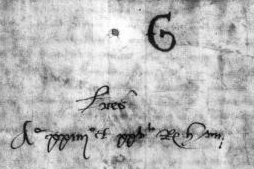 |
24TH and 25TH Regnal year | SP 1/72 f.171 |
H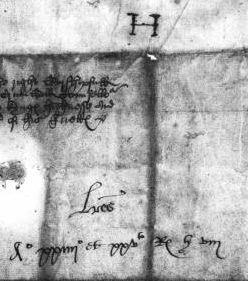 |
24TH and 25TH Regnal year | SP 1/71 f.118 |
I/J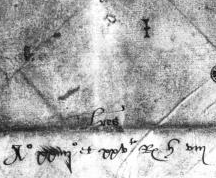 |
24TH and 25TH Regnal year | SP 1/73 f.1 |
L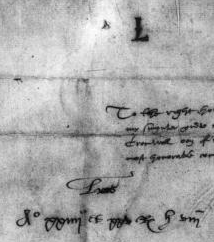 |
24TH and 25TH Regnal year | SP 1/72 f.97 |
O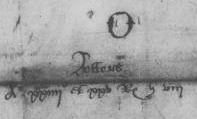 |
24TH and 25TH Regnal year | SP 1/75 f.55 |
F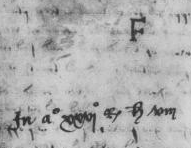 |
26TH Regnal year | SP 1/84 f.102 |
G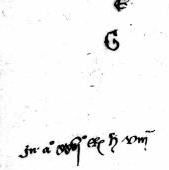 |
26TH Regnal year | SP 1/238 f.125 |
P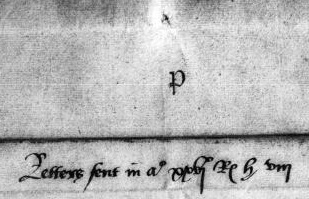 |
26TH Regnal year | SP 1/79 f.178 |
*State Papers Online 1509-1714 is available through the portal Points to the Past.
**Descriptions of the administrative context will help: Mary Robertson’s dissertation from 1975 “Thomas Cromwell’s Servants: The Ministerial Household in Early Tudor Government and Society”, while acknowledging the severe limits on any comprehensive analysis, provides a useful history of this writing office, its staff, and some of its practices. Michael Everett’s book “The Rise of Thomas Cromwell” describes Cromwell’s varied activities in the service of the crown, a noteworthy addition to the study of public administration for this time period.
Cranmer’s letter to Henry VIII
There are two extant letters handwritten by Archbishop Cranmer to Henry VIII which are worded almost the same, addressed, sealed and delivered on the same day in 1533.¹ The appearance of these two near clones in the King’s secretary’s record-keeping system is a strange sight and can seem somewhat bewildering. However, a comparison of the texts explains their relationship, and provides a unique view of the role of the King’s secretariat.
One version is identifiable as the first written and delivered because the same version is copied into Cranmer’s letter-book. He thought the matter was dealt with. If we compare this to the other version we can conclude that the first most have been reviewed by Henry’s secretarial staff and found wanting. The differences are clearly edits. The improved version includes a number of changes, possibly dictated to Cranmer by someone like Thomas Cromwell:
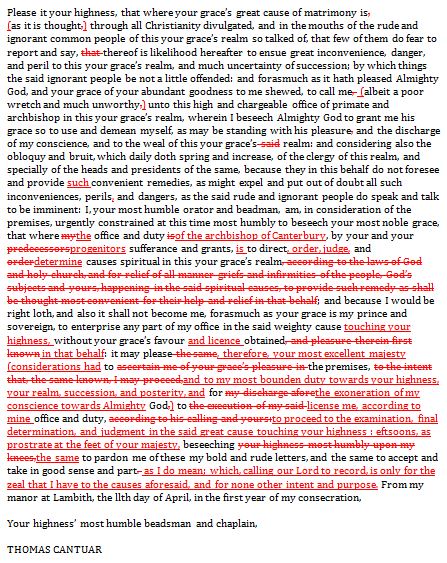
This comparison I created from the modernized texts published in Miscellaneous Writings and Letters of Thomas Cranmer edited by John Edward Cox (1844).
To see why these edits where thought necessary we have to look at the subsequent response authorizing the Archbishop to proceed with the divorce from Catherine. Some of the language used in the license — “order, judge, and determine”, “examination and final determination” — is language added to Cranmer’s request. So, what to me sound like the legal or administrative requirements of the license text were also considered requirements of the request. This is what made it necessary to retroactively change what Cranmer was asking for.
The pair of letters show us that from the perspective of the King’s Secretary the chronological sequence of request and response is not necessarily a restriction on his action. Within his realm of incoming and outgoing mail the Secretary may take whatever action is possible to further the interests of his master. As Ann Stockho describes the role of secretary: “A secretary was an agent of his master, there to articulate the latter’s will, to carry out that will, and even to help formulate that will.”² In this instance we can see how the secretary can go further than this, amplifying what’s possible. Sender and recipient become mere conventions of form.
This extension and magnification of the will of the recipient can be seen in some of the other edits to the letter. These perhaps are intended to strengthen the rhetoric for propaganda purposes, but seem to follow from the Secretary’s single-minded selflessness. Henry does not have “predecessors” but “progenitors”: his kingship is the culmination of natural forces, not mere office holding. In one deft edit Cranmer’s agency is diminished and the petitionary nature of the letter, already advanced, is further emphasized: rather than the author beseeching on his knees to Henry, he is placed prostrate at his feet by the Secretary.
Notes
1. Both of these documents are preserved in the National Archives of the UK (SP 1/75 ff. 78-81). Cranmer’s letter-book is now in the British Museum, (Harl. MS. 6148, f.4.)
2. Stockho, Ann Catherine, “The Master’s Voice: Secretarial Information Management and Gendered Authorship in Works” (2011). English Graduate Theses & Dissertations. Paper 19. (p.2)
Thank you to Louis Cabri and Rhoda Rosenfeld for their performance of the letters at the Projector Verse event on July 23rd.
The Peasants’ Revolt
The English Peasants’ Revolt of 1381 has a continuously re-envisioned history. An event with the appeal of an extraordinary and dramatic social revolution cannot hide from interpretation and narration. The story was once solely reliant on a handful of narratives written by contemporary or near-contemporary writers, but since the 19th century historians have relied also on official records created at the time of the rebellion, which seemed to promise a less biased and more objective view. The textual sources themselves change over time.
This is an account of one archival source, a petition to King Richard II, which has been absent from history, trapped in the clutches of its custodial practices, and in the assumption of its non-existence. The petition provides one small but authentic view of the aims and demands behind the revolt. Since the revolutionaries of the 14th century largely spoke through their actions very little documentary evidence otherwise remains. Continue reading
1259 – An Early (and Late) Bill in Eyre
In the mid-thirteenth century, the foolishness of a king of England, heavily in debt and obligated to the pope for a military adventure in Sicily, forced him to bargain away his domestic power in the hopes of financial relief. Thus, in 1258, a group of peeved magnates with the support of the nobility took over the government of Henry III. Without however challenging the idea of kingship, they then implemented administrative and judicial reforms which, temporarily at least, included the increased use of the querela, a legal proceeding initiated by informal oral complaint. The application of this method followed from the reformer’s desire to investigate the widespread abuse of royal power by local representatives of the crown.
Written complaints in petitionary form of this type are extant from much later in the century, 1292, from the reign of Henry’s more successful son Edward I. (In a previous post I discuss the nature of these “bills in eyre” and include a number of early examples.)
One court roll from the first year of this reform government includes what may be the first reference to a bill: a querela on a written document. The following detail shows the tail end of one of many membranes of a roll created by the English Justiciar Hugh Bigod. Of interest is the small slit at the foot the parchment and accompanying instruction: iunge id est billa “Join, that is the bill”.¹
Here, the bill itself, which may have been only the width of a finger, is long absent. It would have contained the details of a claim of trespass recorded on the same membrane, according to historian Andrew Hershey. As Hershey points out, this reference is unique. If complaints, usually oral, were written on bills these may have been kept with files of writs, now lost, and not usually attached to the roll, even temporarily as this one seemed to be.
The case which Hershey points out may be behind this querela is a dispute between the Abbot of Faversham in Kent and the Constable of Dover Castle. Hershey does not discuss the case or make any inferences about the dispute with regard to the bill. However, it would not be surprising that a Benedictine abbey had the wherewithal to present its case in writing. Ideally the plaint procedure was meant to open up the justice of a centralized authority to even the most humble and poor. The complaint from a powerful ecclesiastic landlord against a member of the reforming government’s newly appointed ruling council and constable of the most important castle in England, was not typical of those heard by Bigod.
In this instance the plaint involved a long standing argument over the manorial rights of the abbey and the community of Faversham. In an effort to escape as much as possible from the obligations and duties of the Abbey (their landlord) the residents had formally associated themselves with the Cinque Port of Dover. The confederation of Cinque Ports enjoyed a great deal of autonomy and power. Although economically and geographically distant from Dover, the townsfolk of Faversham’s agreement brought them under the protection of its charter. This brought them into deliberate conflict with the tenurial rights of the Abbey.²
A sidelong attack on the rights of the abbey was the basis of the written querela. The abbot complained that the new constable of Dover Castle, Richard de Grey, was responsible for holding an illegal court 25 miles away in Faversham, against the liberty of the abbot, and of breaking in to the abbot’s prison and taking prisoners there to his own jail. This sounds like a common kind of jurisdictional dispute over infangenethef, the right to capture and try any thief. For whatever reason Grey seemed to be involving himself in challenging the Abbey’s authority over the town of Faversham. The case was referred by Bigod to the Council, but the arguments continued for hundreds of years.
One of the first acts of this baronial council has been to appoint castellans. Richard de Grey may however have not been the best choice. He was removed from his post the next year for failing to recognize the subterfuge behind the letters allowing into England a papal ally of Henry who was threatening to excommunicate the barons.
An emissary from the pope had been sent to enforce an order in support of the bishop-elect of Winchester, who the reforming council had rightly exiled. The papal nuncio however could not enter the country without official permission, impossible to procure. The council had made sure the chancellor had sworn an oath not to act contrary to the wishes of the council and the ideals of the reform movement. It was the chancellor’s usual practice however to leave the great seal with a subordinate when he was absent from court. No one had thought to have this clerk swear the oath.
Henry, under the noses of the council, used the opportunity of the chancellor’s temporary absence to issue orders and a safe conduct to the constable of Dover Castle, Richard de Grey, who therefore escorted the safely arrived nuncio from Dover to a meeting in London of the king and stunned council. The council of course blamed Grey, he should have known better. But he had acted on what he considered reliable orders; the king however did not have the authority to issue those orders. Grey was duped by a perfectly ordinary order from the crown sealed with the Great Seal, the highest form of warrant. He was relieved of his post and the Justiciar Hugh Bigod replaced him as constable.
But for this kind of oversight, the Council at this time held the machinery of government in its hands, and was willing to correct the abuses of the nobility as well as of the crown. When the abbot’s case was referred to the council, they were still in the midst of transforming local government and creating legal reforms known as the Provisions of Westminster. An attempt was made to extend the investigations of administrative delinquency to all landowners and their representatives. It seemed like a new era of expertise was being born. But the broad use of querela was becoming an issue, and the reforming proposals of the government would eventually stall and mire in the “selfish conservatism of the mass of the baronage.” (Treharne, Baronial, 178)
In discussing the evidence for the existence of written querela, Hershey makes an important distinction between references to a cedula, and references to billa: “the former is a rather nondescript sheet, schedule or document which may have been attached to something else. While the latter, billa, is also a schedule, it carried with it preceptory implications.” (Hershey, Earliest, 231). The distinction will have continuing relevance. Petitionary form is common to many documents including preceptory actions, recognized by a legal system as initiating a procedure. It may be difficult to distinguish these two types of petition by their form alone, but a preceptory petition will likely have particular imposed rules or conventions.
When we see the culmination of Bigod’s judicial mission, reaching the City of London at the end of 1258, we can understand how important this distinction would have been to the clerks of 1259. Londoners, in the words of historian Treharne, “indulged in an orgy of querelae…. The Justiciar, as usual invited all men to show their grievances, and, allowing neither summons nor essoins [excuses] terminated the cases at once without observing the normal procedure. The majority of cases were querela:
“Personal transgressions such as assaults, cases of theft, debt, assignment of dower, disputes on the execution of the terms of a will, alleged disseisins [dispossessions] and other pleas of land….” However, “to the formalism of thirteenth-century land-law, the querela appeared a frivolous method of procedure when applied to the solemn matters of tenure and possession of land…. Whither this outrageous flouting of the grave, decorous and slow forms of established procedure might lead, none could tell. The landowning magnates at once took alarm, for it was in matters of freehold that this lack of orthodoxy seemed most horrible, and the magnates were therefore the chief enemies of the querela. Accordingly, in their charter of February, 1259,³ they insisted that all matters of freehold must be tried by writ and in the customary places. …the tendency to widen the use of the querela was always present, and the barons were very careful to restrict it in future to cases of personal transgression.” (Treharne, Baronial, 152-153)
The coalition of peers soon dissolved, the king regained his power, but then the movement’s ideologues pulled off a successful coup. So for a few years a second farcical stage of reform bloomed, and a dictator was chopped to pieces before royal normalcy set it with the Edwards.
Such a chaotic atmosphere was likely to engender creative bureaucratic methods, such as the temporary attachment of a written querela. At the same time the political structure limited the use of this form of petition. As the government of the crown expanded, carrying with it the selective obligation to dispense justice to all, local private jurisdictions and interests were threatened. Local agents of the crown would also continue to be subject to scrutiny, depending of course on the inclination of whomever ruled. The complainant’s bill would thereafter be more visible in the written record used as an investigative tool in governance and public order.
1. The existence of this reference was first pointed out by Andrew Hershey in his PhD thesis.
2. The history of relations between Faversham and the Abbey, including the Grey episode, are described by Murray.
3. The charter Treharne refers to, also known as the Ordinances of the Magnates, was a description of general aims of the reformers produced by the council as they drafted the details of reform legislation. In it they promise to abide by the same rules imposed on the crown, confirmed by royal letters patent. [Treharne, 137] The ordinationes facte per magnates de consilio regis link [Treharne, 158]
Bibliography
Hershey, Andrew H. An Introduction to and Edition of the Hugh Bigod Eyre Rolls, June 1258-February 1259: P.R.O. Just 1/1 187 & Just 1/873. (unpublished PhD thesis, 1991.) available at EThOS
Hershey, Andrew H., editor. Special Eyre Rolls of Hugh Bigod 1258-1260, vols. 1 & 2, (London : Selden Society, 2021)
Hershey, Andrew H. “The Earliest Bill in Eyre: 1259,” Historical Research, vol. 71 no. 175 (June 1998), pp. 228-232.
Murray, K.M.E. “Faversham and the Cinque Ports,” Transactions of the Royal Historical Society, vol. 18 (Dec. 1935) pp. 53-84.
Treharne, R.F. “An Unauthorized use of the Great Seal under the Provisional Government in 1259,” The English Historical Review, vol. 40 no. 159 (July 1925), pp. 403-411
Treharne, R.F. The Baronial Plan of Reform, 1258-1263. Manchester University Press, 1971.
Links
Justiciar’s (Hugh Bigod’s) roll of assizes, presentments, gaol delivery and essoins, The National Archives (UK). link to description and series description
link to images at AALT and this membrane m.13
1292 Bills in Eyre
In 1292 the English king’s justices at Shrewsbury in Shropshire heard the complaint of Thomas Colle of Shropshire against his brother who owed him money. He brought his legal action before the itinerant and omni-competent Justices of the General Eyre. Since the 12th century English kings had intermittently sent judges out on these visitations to the country, extending royal justice and power.
The usual procedure for a civil action such as Thomas Colle’s was to purchase a writ from Chancery. In this case the action was commenced by querela, a less costly and faster procedure based on an oral complaint. Over time the oral complaint was augmented by a written form, the bill. Bill procedure however played only a small part in the business of the eyre.
Except for a few instances, the bill was written out for the complainant by an experienced writer: perhaps a clerk of the local bailiff or sheriff, or a clerk of the justices. The bill’s 3rd person wording usually followed a typical form: an address to the king’s justices, the details of a grievance, and a prayer for remedy:
A les Justices nostre Seignour Le Roys se ple [sic] pleint Thomas Colle de Slobirs de Richard Colle de Slobirs de ceo ke memes cely Richard atort ly detent vj.li. e xv. souz lequeus il ly deit pur drap de la pris e en deners a ly aprestez par parceles dunt cely Thomas en ad taill encuntre li e rendre ne ly vost a gref damayges cely Thomas de Cent souz e de ceo prie remedie pur deu.
[Thomas Colle of Shrewsbury complaineth to the Justices of our Lord the King of Richard Colle of Shrewsbury that that same Richard wrongfully detaineth from him £6 15s. which he oweth to him for cloth bought all at one time and for money lent to him in sundry sums, in acknowledgement whereof the said Thomas hath a tally; which sum the said Richard will not pay him, to the grievous damage of this Thomas of a hundred shillings. And of this he prayeth remedy for God’s sake. (transcribed and translated by Bolland)]
Another writer, a clerk of the court, would use the bill to make annotations as the case progressed. Here the back of the bill has the names of two pledges for prosecution, Thomas and Alan:
The result was that brother Richard acknowledged to the judges his debt and promised to pay what he owed, in installments.
Thomas Colle’s bill begins the selections transcribed, translated into antiqued English, and published by William Bolland in 1914. See this link for a PDF of Select Bills in Eyre, A.D. 1292-1333. Those of 1292 and 1293 are probably the earliest extant.
This amazing preservation is due to luck and neglect as well as modern conservation. The bills were strung on thongs when finished with. These files were eventually submitted to the treasury along with files of writs and the justices’ rolls, but really of no use to anyone, and largely ignored by historians. Today the individual bills are preserved in volumes at the National Archives in the UK.
The stories related in the bills can be exciting, mystifying and commonplace. Not as typical as the familial complaint of Colle’s is the cry for mercy of bill 11, written by the complainant himself, appealing to the king’s desire to bring justice to rich and poor alike:
Cher sire joe vus cri merci issi com vus estis mis en lu nostur seinur le Roy pur dreit fere a poueris e a riches. Joe Johan Feyrewyn face pleint a deu e a vus Sire Justice ke Richard le Carpenter Clerk du bayli de Salopesburie ke le vaundist Richard me de teent .vj. mars le quenz joe li bayla par escrit ke il meme Richard moy Johan dute trouer me sustinaunce pur le deners le queus il resu de moy e ne fe mie cum couenaunt fu entre nous mes ausi tot com il auoit les deners il me desoula e me fit sere par le trunc e me dona vn leyke de pain ausi com ce fu vn pouere homme ke demaunde vn pain pur deu e me morit pres de feim. E pur ce Cher Sire joe vus cri merci pur deu ke vus me facers auer me deners auaunt ke vus partus ors de sete vile autrement ne recouerai jammes me deners ke sachers le riche gent tendrunt a semble ke le pouere gent nauerunt nul dreit en sete vile, ausi tot moun seynur ki joe ai me deners joe me vois en le tere seint e priera pur le Roy de Engletere e pur vus nomement Sire John de Berrewyke. Ke sachers ki joe nai dener ne mayl pur pleyter. E pur ce Cher Sire ei merci de mey ki joe ei me deners. [transcribed by Bolland from JUST 1/1552/11]
These and other photographs of the filed bills from which Bolland selected can be viewed at the Anglo-American Legal Tradition website.
The following table lists the earliest bills published by Bolland, with links to the AALT images that I have been able to identify:
Bills in the Eyre of Shropshire of 20 Edward I [1292]
These bills are held by the UK National Archives series JUST 1, files 1552 /1553 /1554
Bills in the Eyre of Staffordshire 21 Edward I [1293]
These bills are held by the UK National Archives series JUST 1, files 1553 /1554
61 62 63 64 65 66 67 68 69 70 71 72 73 74 75 76 77 78 79 80 81 82 83 84 85 86 87 88 89 90 91 92 93 94 95 96 97 98 99 100 101 102 103 104 105 106 107 108 109
Bills in the Eyre of Lincolnshire 14 Edward I [1285]
Bolland has probably misidentified these three bills. David Crook points out there was no Eyre in Lincolnshire at this time, and the bills are not Eyre bills.
Bibliography
Baker, J.H. An Introduction to English Legal History 4th ed. Oxford 2007.
Bolland, William, ed. Select Bills in Eyre, A.D. 1292-1333 Seldon Society no. 30 (1914) link
Crook, David. Records of the General Eyre. London : H.M.S.O., 1982.
Harding, Alan. “Plaints and Bills in the History of English Law, Mainly in the Period 1250-1330” in Legal History Studies 1972. Cardiff : University of Wales Press, 1975.
Chaucer’s Customs Petition: (part 2) the Writers
Adam
A reproduction of Chaucer’s 1385 petition is published in The British Inheritance: A Treasury of Historic Documents, from which the following images were made. The caption to the reproduction states in part: “It is probable that one of these hands is Chaucer’s, but it is impossible to say which.” (p.31) This is clearly mistaken.
Although there are no positively known samples of Chaucer’s handwriting with which to compare, the text of the petition was probably not written by Chaucer, but by a hired public scrivener, possibly by the name of Adam Pinkhurst.
This identification is the conclusion of Chaucer scholar Simon Horobin based on his paleographic analysis of the petition, as well as other scholarship identifying Pinkhurst as a scribe who worked on the earliest extant copies of Chaucer’s poetry. Pinkhurst is known to have been a member of the scrivener’s company guild in London, and probably was employed to copy or write a variety of document types, some requiring the use of the functional and terse court-hand seen in Chaucer’s petition, as well as a more literary hand. Chaucer presumably went to the shop of this scrivener with a draft, to have it written out in a professional manner.
An additional piece of literary evidence put forward for the identification is a short poem by Chaucer from this time period “Wordes unto Adam, His Owne Scriveyn”:
Adam scriveyn, if ever it thee bifalle,
Boece or Troylus for to wryten newe,
Under thy long lokkes thou most have the scalle,
But after my makyng thow wryte more trewe;
So ofte adaye I mot thy werk renewe,
It to correcte and eke to rubbe and scrape,
And al is thorugh thy negligence and rape.
I wonder if Chaucer had also to correct his scribe, clearly accustomed to writing quickly, when he produced his petition.
Robert
The writer of the notification of the king’s assent, above the text of the petition,
and the signature below,
was Robert de Vere, ninth earl of Oxford. De Vere was Chamberlain of England, and the eighteen-year old king’s close political ally and recipient of largesse. In converting the petition to a warrant for the issue of letters patent under the great seal he was acting in a secretarial capacity for the king. He uses the name Oxen, short for Oxenford, and includes a scribbled graphic element. In Life-Records this is described merely as an asterisk, a description repeated by every other writer on the subject. Upon close examination however, and visible in other examples, one can see it is a five-pointed star, in heraldic terminology a “mulet”. The Earl of Ox[en]ford uses it here as an emblem representing his family name of De Vere, who held a hereditary claim to the office of Chamberlain of England.
The star is a prominent and famous element of the De Vere coat of arms. There are at least two stories in which this mulet plays a leading role. The first is the 11th century origins of the De Vere star, a legendary episode of the crusades, in which an army is saved by God’s intercession on behalf of the Christian crusaders, shining a saving light on the standard of Audrey de Vere on a night of fighting near Antioch. The second, more absurd episode occured during the Wars of the Roses. At the foggy Battle of Barnet in 1471 an army mistook the flags of its ally (a De Vere) for that of its enemy, fumed at the sight of white roses (or perhaps splendorous suns), attacked their ally, and the battle turned.
Bibliography
Crow, Martin Michael, Clair Colby Olson, and John Matthews Manly. Chaucer Life-Records. [Austin]: University of Texas Press, 1966.
Gillespie, Alexandra. “Reading Chaucer’s Words to Adam.” The Chaucer Review. 42.3 (2008): 269-283.
Horobin, Simon. “Adam Pinkhurst, Geoffrey Chaucer, and the Hengwrt Manuscript of the Canterbury Tales.” The Chaucer Review. 44.4 (2010): 351-367.
Hulbert, J R. “Chaucer and the Earl of Oxford.” Modern Philology. 10.3 (1913): 433-437.
Mooney, Linne R. “Chaucer’s Scribe.” Speculum. 81.1 (2006): 97-138.
Prescott, Andrew. “Administrative Records and the Scribal Achievement of Medieval England.” in Edwards, Anthony S. G, and Orietta Da Rold, eds. English Manuscript Studies, 1100-1700: Volume 17. London: The British Library, 2012.
Prescott, Andrew, and Elizabeth M. Hallam. The British Inheritance: A Treasury of Historic Documents. Berkeley: University of California Press. 1999.
links:
http://www.theguardian.com/uk/2004/jul/20/highereducation.books
Chaucer’s Customs Petition: Introduction
In 1385 Geoffrey Chaucer, who held the office of controller of wool customs at London, requested permission from the king to appoint a sufficient deputy for as long as he held the office. The following is the text of his petition to Richard II preserved in the UK National Archives [C81/1394/87], published in Life-Records of Chaucer:

Life-Records of Chaucer, Part IV ed. R.E.G Kirk, London : Published for the Chaucer Society by K. Paul, Trench, Trübner & Co., 1900 .p.251
The brief notes to the text provide some basic information about the petition: that it is written in an ordinary chancery clerk’s hand, probably not written by Chaucer himself, and signed by the ninth earl of Oxford.
At this time Chaucer had been a London customs controller for about 10 years, having been appointed by Edward III to this minor but politically sensitive office. The controller acted as a royal check on the accounts of the collector of customs. An early biography of Chaucer describes the episode in an inventive and dreamy fashion. This is from Chaucer’s Life by Walter Skeat:
In 1385, a stroke of good fortune befell him, which evidently gave him much relief and pleasure. It appears that Chaucer had asked the king to allow him to have a sufficient deputy in his office as Comptroller at the Wool Quay (in French, Wolkee) of London. And on Feb. 17, he was released from the somewhat severe pressure of his official duties (of which he complains feelingly in the House of Fame, 652-660) by being allowed to appoint a permanent deputy. He seems to have revelled in his newly-found leisure; and we may fairly infer from the Prologue to the Legend of Good Women, which seems to have been begun shortly afterwards, that he was chiefly indebted for this favour to the good queen Anne.
In the 1920’s a new project to publish the Life Records was begun, with the aim to provide a foundation of primary sources on which biographers and historians could rely. This was eventually published in 1966 as Chaucer Life-Records. This edition provides extremely rich descriptions of all the documents printed, including the 1385 petition. There is a valuable discussion also of the operations of the customs service, and the types of records it produced.
Here are some of the descriptive details this edition includes: “the signature (with an asterisk) and the phrase Le roy lad grante are in another ink and in the same, contemporary, hand, much less formal than that of the record itself….”, the “notification of assent [Le roy lad grante] and the name Oxen below is probably that of Robert de Vere, the ninth earl of Oxford …. by this addition the record became a sufficient warrant for the sealing of the letters patent ….” [p. 169] The background provided by the editors further explain that permission to appoint a deputy for a controller was rare. As a writer of a counter-roll representing the king’s interests at the audit of the collector’s accounts, the controller was expected to perform his duties in person and must have done so. Chaucer however had been given permission to appoint a temporary deputy on a few occasions prior to this, because he was directed to perform other duties on behalf of the king.
The actual letters patent issued to the controller has not survived. However, the enrolment of this license on the Patent Rolls is in the UK National Archives [C66, 8 Ric. II, Pt. 2, m. 31]. The text of the enrolment is published in Chaucer Life-Records (p. 168-9):
Pro Galfrido Chaucer.
Rex omnibus ad quos etc. salutem. Sciatis quod de gracia nostra speciali concessimus et licenciam dedimus dilecto nobis Galfrido Chaucer contrarotulatori custumarum et subsidiorum nostrorum in portu civitatis nostre Londonie quod ipse officium predictum per sufficientem deputatum suum pro quo respondere voluerit facere et excercere possit quamdiu idem Galfridus in officio steterit supradicto absque impedimento collectorum custumarum et subsidiorum nostrorum predictorum in portu predicto pro tempore existencium (seu aliorum quorumcumque). In cuius etc. Teste rege apud Westmonasterium xvii Februarii.
Per ipsum regum
There is no evidence Chaucer used this permission to appoint a deputy, and lost the position the next year.
But I am not here especially concerned with the biography of Chaucer. In following posts I will describe the brief life of his petition.
Bibliography
Crow, Martin M. and Clair C. Olson, eds. Chaucer Life-Records. Oxford: Clarendon Press, 1966.
